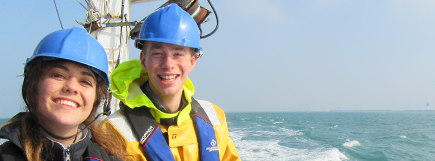Introduction to Safety
Code UE : HBB320
- Cours + travaux pratiques
- 3 crédits
- Volume horaire de référence
(+ ou - 10%) : 30 heures
Responsable(s)
Claire MARION
Objectifs pédagogiques
Module Outline:
GMDSS
Describe the means by which navigational warnings are provided to ships at sea using Global Marine Distress and Safety System.
Explain how to obtain and apply navigational warnings.
Explain the relative advantages of VHF, SSB, wireless telephone and satellite communications.
List the important VHF channels and their uses for vessels.
Use the Admiralty List of Radio Signals and GMDSS.
Explain the operation of Emergency Position Indicating Radio Beacons (EPIRB).
Describe how vessel traffic services (VTS) operate and where to find the necessary information.
SAFETY
How to communicate with other persons on board on elementary safety matters and understand safety information symbols, signs and alarm signals.
Know what to do if:
Locate and don life jackets.
How to raise the alarm and have basic knowledge of the use of portable fire extinguishers.
How to take immediate action upon encountering an accident or other medical emergency before seeking further medical assistance on board.
Know how to close and open the fire, weathertight and watertight doors fitted in a ship other than those for hull openings.
Know how to survive at sea in the event of ship abandonment.
Know how to comply with emergency procedures.
Know how to take precautions to prevent pollution of the marine environment.
Know how to observe safe working practices.
Know how to contribute to effective communications on board ships.
Know how to contribute to effective human relationships on board ships.
Understand and know how to take necessary actions to control fatigue.
GMDSS
Describe the means by which navigational warnings are provided to ships at sea using Global Marine Distress and Safety System.
Explain how to obtain and apply navigational warnings.
Explain the relative advantages of VHF, SSB, wireless telephone and satellite communications.
List the important VHF channels and their uses for vessels.
Use the Admiralty List of Radio Signals and GMDSS.
Explain the operation of Emergency Position Indicating Radio Beacons (EPIRB).
Describe how vessel traffic services (VTS) operate and where to find the necessary information.
SAFETY
How to communicate with other persons on board on elementary safety matters and understand safety information symbols, signs and alarm signals.
Know what to do if:
- A person falls overboard,
- Fire or smoke is detected, or
- The fire or abandon ship alarm is sounded.
Locate and don life jackets.
How to raise the alarm and have basic knowledge of the use of portable fire extinguishers.
How to take immediate action upon encountering an accident or other medical emergency before seeking further medical assistance on board.
Know how to close and open the fire, weathertight and watertight doors fitted in a ship other than those for hull openings.
Know how to survive at sea in the event of ship abandonment.
Know how to comply with emergency procedures.
Know how to take precautions to prevent pollution of the marine environment.
Know how to observe safe working practices.
Know how to contribute to effective communications on board ships.
Know how to contribute to effective human relationships on board ships.
Understand and know how to take necessary actions to control fatigue.
Compétences visées
Learning Outcomes:
Basic knowledge of subjects, methodology and their practice
Ability to identify, understand, apply and evaluate.
The student possesses qualities required by the STCW code, content of the Safety Familiarisation training.
The student is provided with the necessary technical knowledge for general insight in the use of telecommunication equipment.
Basic knowledge of subjects, methodology and their practice
Ability to identify, understand, apply and evaluate.
The student possesses qualities required by the STCW code, content of the Safety Familiarisation training.
The student is provided with the necessary technical knowledge for general insight in the use of telecommunication equipment.
Contenu
Lecture 1 Fire extinguishing tools and systems
Learn how to use the identify the different kinds of fire-extinguishers and how to use them.
Knowing the different kinds of automatic fire extinguish system and their use
Lecture 2 Survival suits and breathing apparatus
Knowing the importance of survival technics and how to survive in a case of emergency.
Lecture 3 Small boats, lifeboats and life rafts
Lecture 4 Fire and boat drills
Lecture 5 Safety Procedures (ISM)
Lecture 6 GMDSS part 1
Introduction into the radio communication functions and the different communication systems & basic terminology like wave propagation, wavelength and modulation.
EPIRB & SART & AIS-SART: working principle and illustration SART.
MSI general concept explained and NAVTEX basic working principle and illustration
practical 1 GMDSS part 2
Radio communication: distress calls, urgency calls, safety calls, routine calls with Maritime English (elementary / basic) for radio-calls
VHF – DSC & WATA: basic working principle explained and illustration
VTS explained
Learn how to use the identify the different kinds of fire-extinguishers and how to use them.
Knowing the different kinds of automatic fire extinguish system and their use
Lecture 2 Survival suits and breathing apparatus
Knowing the importance of survival technics and how to survive in a case of emergency.
Lecture 3 Small boats, lifeboats and life rafts
Lecture 4 Fire and boat drills
Lecture 5 Safety Procedures (ISM)
Lecture 6 GMDSS part 1
Introduction into the radio communication functions and the different communication systems & basic terminology like wave propagation, wavelength and modulation.
EPIRB & SART & AIS-SART: working principle and illustration SART.
MSI general concept explained and NAVTEX basic working principle and illustration
practical 1 GMDSS part 2
Radio communication: distress calls, urgency calls, safety calls, routine calls with Maritime English (elementary / basic) for radio-calls
VHF – DSC & WATA: basic working principle explained and illustration
VTS explained
Modalité d'évaluation
- Contrôle continu
- Examen final
Cette UE apparaît dans les diplômes et certificats suivants
Rechercher une formation
CRITERES
- Le champ Mot-clé permet de rechercher les formations grâce à un mot ou à une expression présent dans l’intitulé ou dans les index d’une formation.
Des index vous sont suggérés à partir du 3e caractère saisi, mais vous pouvez aussi saisir librement tout autre chaîne de caractères . - les différents items sélectionnés sont croisés.
ex: "Comptabilité" et "Région Alsace"
CODE
- Vous pouvez utiliser le caractère joker * pour remplacer un nombre quelconque de caractères
- UE : le code comprend 3 lettres immédiatement suivies de 3 chiffres
- Certificat : le code comprend 2 ou 3 lettres immédiatement suivies de 3 chiffres. Certains certificats se déclinent selon plusieurs parcours :
- pour afficher le tronc commun, tapez le code simple (ex : LG005).
- pour afficher un parcours précis dans un diplôme, faites suivre le code de la lettre "p", et du numéro de parcours (ex : LG005p2). Si le diplôme ne comporte qu'un seul parcours, faites suivre la lettre "p" de -1 (ex : CYC17p-1).
Dans tous les cas, veillez à ne pas insérer d'espace ou de ponctuation supplémentaire.
Chargement du résultat...

Intitulé de la formation |
Type |
Modalité(s) |
Lieu(x) |
|
|---|---|---|---|---|
Intitulé de la formation
Bachelor océanographe prospecteur
|
Lieu(x)
Initial
|
Lieu(x)
Normandie, Paris
|
||
| Intitulé de la formation | Type | Modalité(s) | Lieu(x) |
Contact
Voir le calendrier, le tarif, les conditions d'accessibilité et les modalités d'inscription dans le(s) centre(s) d'enseignement qui propose(nt) cette formation.
Enseignement non encore programmé
Code UE : HBB320
- Cours + travaux pratiques
- 3 crédits
- Volume horaire de référence
(+ ou - 10%) : 30 heures
Responsable(s)
Claire MARION











